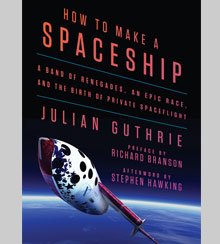strategy+business, January 25, 2017
by Theodore Kinni
 Stephen Hawking believes we humans won’t survive another thousand years unless we colonize space. And if we do colonize space, people will probably erect statues of Peter Diamandis in town squares across the universe. At least that’s the impression that ex–San Francisco Chronicle reporter Julian Guthrie gives in How to Make a Spaceship (Penguin, 2016).
Stephen Hawking believes we humans won’t survive another thousand years unless we colonize space. And if we do colonize space, people will probably erect statues of Peter Diamandis in town squares across the universe. At least that’s the impression that ex–San Francisco Chronicle reporter Julian Guthrie gives in How to Make a Spaceship (Penguin, 2016).
In Spaceship, Guthrie tells the story of the Ansari XPrize and of SpaceShipOne — the privately developed, piloted craft that, in 2004, won the US$10 million competition by flying into space and back twice within two weeks. Although it was an inspirational feat, the book is a bit of a mixed bag. It’s a terrific yarn, to be sure. But it’s also an overly detailed biography of Diamandis that verges on hagiography and a missed opportunity to explore how new industries emerge from the intersection of government and the private sector.
Diamandis was 8 years old when Neil Armstrong stepped onto the moon in 1969. Like millions of American kids of similar age, he dreamed of becoming an astronaut. Unlike almost all those other kids, he never outgrew the dream — even as he attended Harvard Medical School, where he graduated only after promising the school’s dean never to actually practice medicine.
Instead, Diamandis became a serial entrepreneur in the space business. Among the numerous ventures he cofounded and led from the late 1980s to the 2000s were International Microspace, which provided low-cost satellite launch services; Zero Gravity, which offered well-to-do thrill-seekers parabolic “weightlessness” flights in a Boeing jet; and BlastOff, which aimed to fly a mission to the moon. The business results of his ventures were mixed at best: Zero Gravity is the only one of these three still operating independently. But in zooming from one business to another, Diamandis got the idea to jumpstart a private-sector space race with a prize — a competition modeled on the $25,000 Orteig Prize that prompted Charles Lindbergh’s solo flight across the Atlantic in 1927. Read the rest here.
Wednesday, January 25, 2017
Peter Diamandis’s Excellent Adventure
Posted by
Theodore Kinni
at
5:42 PM
![]()
Labels: bizbook review, books, business history, corporate success, creativity, entrepreneurship, innovation, leadership, space, strategy+business, technology
Subscribe to:
Post Comments (Atom)















No comments:
Post a Comment